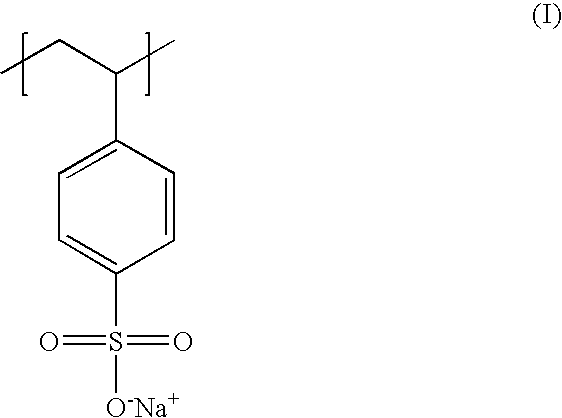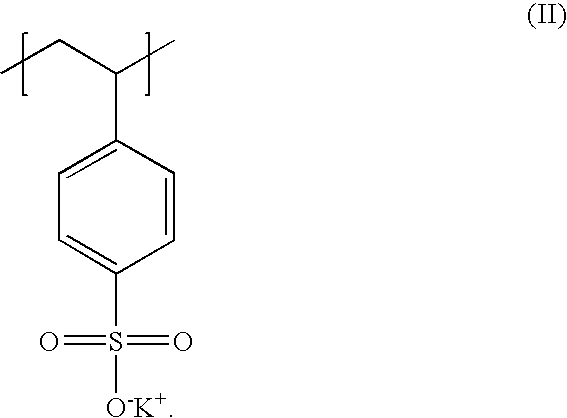Poly(potassium and sodium styrene sulfonate) its manufacture and its uses
a technology of sodium styrene sulfonate and polystyrene sulfonate, which is applied in the field of polystyrene sulfonate's manufacture, can solve the problems of increased morbidity and mortality, septic shock, lethal toxins to the host organism, etc., and achieves the effect of inhibiting or preventing relapse and being easy to prepar
- Summary
- Abstract
- Description
- Claims
- Application Information
AI Technical Summary
Benefits of technology
Problems solved by technology
Method used
Image
Examples
example 1
Protection of Vero Cells from Cytotoxicity Caused by C. difficile Toxins A and B
[0040] Confluent monolayers of Vero cells (ATCC#CCL-81) were prepared in 96 well microtitre trays. Purified C. difficile toxins A or B were obtained from TechLab (TechLab, Blacksburg Va.). The monolayers were incubated with C. difficile toxin A (10 ng / ml) or toxin B (1 ng / ml) in the presence of serial dilutions of polymers. These toxin concentrations were previously found to cause 100% cell rounding in 18-24 hours. Cells were observed at 24 hours and scored for cell rounding. The concentration of polymer that provided 100% protection from cell rounding is reported in Table 1. Results represent means of duplicate wells.
TABLE 1Polymer concentration providing 100% protection of Vero Cellmonolayers from toxin A and toxin B mediated cell rounding.Concentration ofpolymer (mg / ml)providing 100%protection fromtoxin A or toxin BPolymerToxin AToxin BSodium Polystyrene0.0038-0.00781.25SulfonatePoly (Potassium an...
example 2
Preparation of Sodium / Potassium Polystyrene Sulfonate by Potassium Chloride Addition and Ultrafiltration
[0042] Dry solid sodium polystyrene sulfonate powder was dissolved in deionized water to produce 500 g of a 1% w / w polystyrene sulfonate solution. Potassium chloride (1.032 g) was added to the solution, which was then subjected to ultrafiltration (UF). UF involved concentrating the solution from 1% w / w to 2% w / w polystyrene sulfonate five times using a 300 kDa cut-off membrane, and diluting the solution to 1% w / w polystyrene sulfonate between steps with deionized water. The UF process was run at a temperature between 40° C. and 60° C.
[0043] The product of this synthesis was analyzed by inductively-coupled plasma optical emission spectrometry (ICP-OES). Samples were analyzed using direct infusion ICP-OES analysis against a NaCl / KCl calibration curve, as 1:50 diluted neat samples and after ultracentrifugation (30 minutes at 14000×g through a 10 kDa Nanosep filter). ICP-OES analys...
example 3
Preparation of Sodium / Potassium Polystryene Sulfonate Copolymer
[0044] A reactor was filled with 200 L purified water, followed by 26.2 kg sodium styrene sulfonate and 15.1 kg potassium styrene sulfonate. The contents of the reactor were heated to about 80° to 85° C. to form a solution. A solution of 57 g sodium persulfate in 1 L purified water was added to the reactor to form the sodium / potassium polystyrene sulfonate copolymer. The contents of the reactor were stirred for about 21 hours at a temperature of about 80° to 90° C. The contents of the reactor were then cooled to about 32° C.
[0045] The contents of the reactor were emptied into a drum and approximately one-eighth of the solution (30 kg) was added back into the reactor, and diluted with 200 L purified water. This mixture was stirred for about 30 minutes and was then emptied into a drum. This dilution step was repeated for the other seven approximately 30 kg portions of the solution.
[0046] Approximately half of the dilut...
PUM
| Property | Measurement | Unit |
|---|---|---|
| weight | aaaaa | aaaaa |
| weight | aaaaa | aaaaa |
| w/w | aaaaa | aaaaa |
Abstract
Description
Claims
Application Information
 Login to View More
Login to View More - Generate Ideas
- Intellectual Property
- Life Sciences
- Materials
- Tech Scout
- Unparalleled Data Quality
- Higher Quality Content
- 60% Fewer Hallucinations
Browse by: Latest US Patents, China's latest patents, Technical Efficacy Thesaurus, Application Domain, Technology Topic, Popular Technical Reports.
© 2025 PatSnap. All rights reserved.Legal|Privacy policy|Modern Slavery Act Transparency Statement|Sitemap|About US| Contact US: help@patsnap.com


